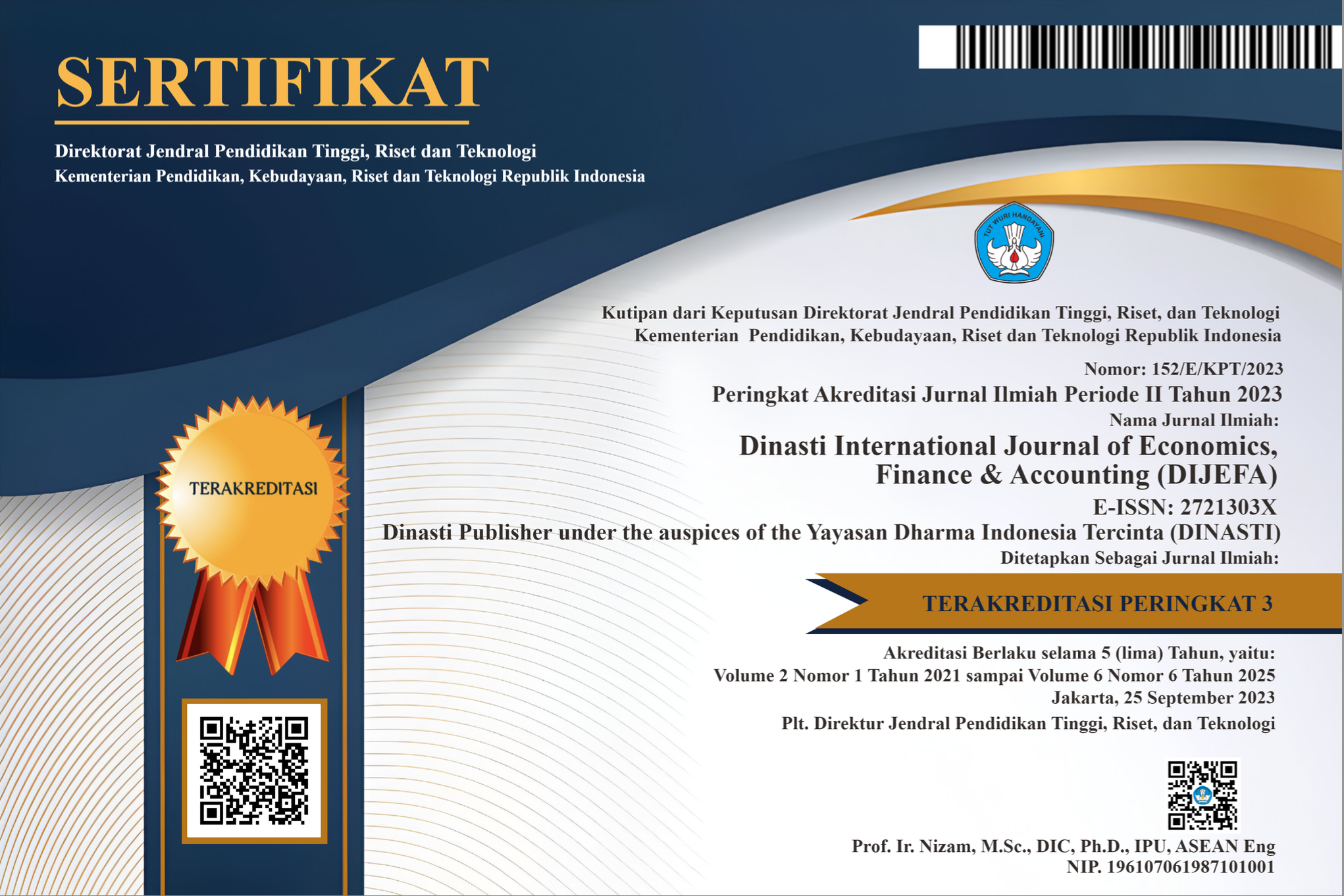ANALYSIS OF EXPORT COMPETITIVENESS TEXTILE AND APPAREL INDONESIA, CHINA, INDIA
DOI:
https://doi.org/10.38035/dijefa.v1i1.207Keywords:
Competitiveness, Herfindahl, TSR, RCA, CMSAbstract
The textile and apparel industries are labor-intensive and capital-intensive industries. The focus of this research looks at the competitiveness of textiles and apparel in Indonesia, China and India. The research method used is comparative descriptive, with the Herfindahl approach, Trade Specialization, Relevealed Comparative Adventage and Constan Market Share. Herfindahl calculation shows the market structure in Indonesia, China and India in the form of perfect competition. While the Trade Specialization approach, Indian exports are more stable than Indonesia and China. The TSR approach generally shows Export Promotion. The Revealed Comparative Adventage approach, Indonesia and India show stable and stagnant results, the RCA scale shows that China has a comparative advantage and strong competitiveness. Conclusion of the research, the market structure takes the form of a perfect competition and Export Promotion. China Has comparative advantages and strong competitiveness, followed by Indonesia and India.
References
Amador, J., & Cabral, S. (2008). The portuguese export performance in perspective: A constant market share analysis. Economic Bulletin and Financial Stability Report, 201–221. http://www.bportugal.pt/en-US/BdP Publications Research/AB200813_e.pdf
Guan, Z., Xu, Y., Jiang, H., & Jiang, G. (2019). International competitiveness of Chinese textile and clothing industry – a diamond model approach. Journal of Chinese Economic and Foreign Trade Studies, 12(1), 2–19. https://doi.org/10.1108/JCEFTS-01-2018-0003
Jayawickrama, A., & Thangavelu, S. M. (2010). Trade linkages between China, India and Singapore: Changing comparative advantage of industrial products. Journal of Economic Studies, 37(3), 248–266. https://doi.org/10.1108/01443581011061267
Kathuria, L. M. (2013). Analyzing competitiveness of clothing export sector of india and Bangladesh: Dynamic revealed comparative advantage approach. Competitiveness Review, 23(2), 131–157. https://doi.org/10.1108/10595421311305343
Kathuria, L. M. (2018). Comparative advantages in clothing exports: India faces threat from competing nations. Competitiveness Review, 28(5), 518–540. https://doi.org/10.1108/CR-01-2017-0010
Kilduff, P., & Chi, T. (2007). Analysis of comparative advantage in the textile complex: A study of Eastern European and former Soviet Union nations. Journal of Fashion Marketing and Management, 11(1), 82–105. https://doi.org/10.1108/13612020710734427
Lieberman, E. S. (2005). for Comparative Research APPROACH. 99(3), 435–452.
Mahajan, V. (2019). Structural changes and trade competitiveness in the Indian pharmaceutical industry in product patent regime. International Journal of Pharmaceutical and Healthcare Marketing, 13(1), 21–39. https://doi.org/10.1108/IJPHM-12-2016-0066
Maryam, J., Banday, U. J., & Mittal, A. (2018). Trade intensity and revealed comparative advantage: an analysis of Intra-BRICS trade. International Journal of Emerging Markets, 13(5), 1182–1195. https://doi.org/10.1108/IJoEM-09-2017-0365
Mcauliffe, R. E. (2014). ). In its treatment, the market shares are expressed as percentages by the Department of Justice. Martin (2010) provides a useful overview of the HHI. 2014.
Nordås, H. K., & Geneva, C.-. (n.d.). The Global Textile and Clothing Industry post the.
Saki, Z., Moore, M., Kandilov, I., Rothenberg, L., & Godfrey, A. B. (2019). Revealed comparative advantage for US textiles and apparel. Competitiveness Review, 29(4), 462–478. https://doi.org/10.1108/CR-03-2018-0025
Suwannarat, P. (2017). Ascertaining the competitiveness of Thai exports to PRC. 27(3), 275–299. https://doi.org/10.1108/CR-04-2016-0026
Downloads
Published
How to Cite
Issue
Section
License
Authors who publish their manuscripts in this journal agree to the following conditions:
- The copyright on each article belongs to the author(s).
- The author acknowledges that the Dinasti International Journal of Economics, Finance & Accounting (DIJEFA) has the right to be the first to publish with a Creative Commons Attribution 4.0 International license (Attribution 4.0 International (CC BY 4.0).
- Authors can submit articles separately, arrange for the non-exclusive distribution of manuscripts that have been published in this journal into other versions (e.g., sent to the author's institutional repository, publication into books, etc.), by acknowledging that the manuscript has been published for the first time in the Dinasti International Journal of Economics, Finance & Accounting (DIJEFA).


























































